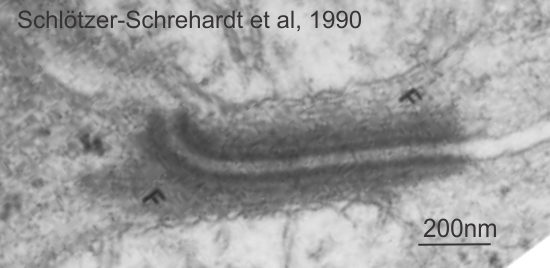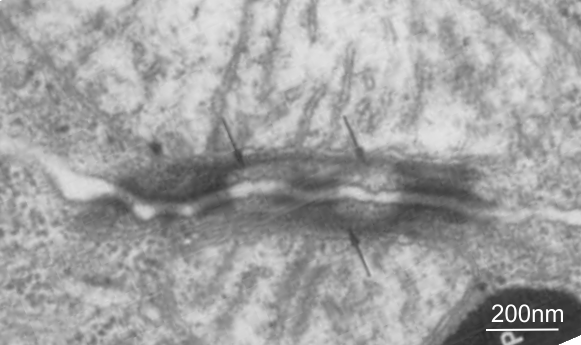148nm from plasmalemma to mitochondrial outer membrane, they measure 63 to 84 from the outer limits of the desmosome (a hard place to judge), and they note that there is a lucent area (of about 5 nm, or half the diameter of an intermediate filament) between each of the dense lines of the intermediate filaments and the mitochodnrion.
41nm is intercellular space of the desmosome.
815nm=length of this particular desmosome (approximate).
Annulus=about 74nm of plasma membrane increased density on either side of the desmosome.
3 to 5 intermediate filaments parallel to mitochondrion and desmosome.
 Schlötzer-Schrehardt et al 1990 also mention that there can be just one mitochondrion with one desmosome on one cell of the two involved, or there can be bilateral symmetry (i.e. one mitochondrion on one desmosome in each of the attached cells, or strings of desmosomes linked by one single mitochondrion…or a mirror. They show an image (below) of eight tethers, two mitochondria, five desmosomes, the latter spaced variably (they measured 50 – 350nm). They also remarked that when there were multiple tethers, that the intermediate filaments were more prominently arranged.
Schlötzer-Schrehardt et al 1990 also mention that there can be just one mitochondrion with one desmosome on one cell of the two involved, or there can be bilateral symmetry (i.e. one mitochondrion on one desmosome in each of the attached cells, or strings of desmosomes linked by one single mitochondrion…or a mirror. They show an image (below) of eight tethers, two mitochondria, five desmosomes, the latter spaced variably (they measured 50 – 350nm). They also remarked that when there were multiple tethers, that the intermediate filaments were more prominently arranged.
28nm=intercellular space of these desmosomes
113nm=mean length (n=5) of this particular desmosomal set, longest is about 168nm (that would be something less than the anticipated measurement of the diameter).
70nm from plasmalemma to mitochondrial outer membrane (mean of four measurements).
63nm=annulus
4 intermediate filaments parallel to desmosome and mitochondria in one opportune space (lower left of this micrograph).
 Schlötzer-Schrehardt et al 1990 commented of the possibility of calcium being one of the reasons for such tethers. Aside from the anatomical location such a large frequency of desmites providing clues as to the energy required for rapid and frequent adjustment of the iris, and the likely stress on the cells…. the need for an energy resource is pretty obvious, as would be the need for releasing stretched areas from their bonds.
Schlötzer-Schrehardt et al 1990 commented of the possibility of calcium being one of the reasons for such tethers. Aside from the anatomical location such a large frequency of desmites providing clues as to the energy required for rapid and frequent adjustment of the iris, and the likely stress on the cells…. the need for an energy resource is pretty obvious, as would be the need for releasing stretched areas from their bonds.
I wonder if ciliary processes represent a tissue with extraordinary desmite adaptability and pliability. I will work to produce an excel file with all the tissues I can find, and notations (or actual counts as provided in the Schlötzer-Schrehardt et al 1990 publication.